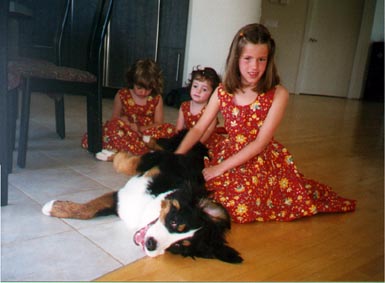Growing up with a family dog can be a marvelous. Leaming to respect,
understand, care for, and successfully control a dog gives a dramatic boost
to any child's self esteem. But the above benefits do not come by magic.
Children and parents alike must realize, that cartoon dogs are fantasy,
and that Lassie was several well-trained dogs. All owners should seek family
puppy training classes, in which both puppies and children are allowed off-leash.
just as all dogs must learn how to act around children, (especially dogs
living in homes without children), all children must learn how to act around
dogs.
Every family member, children included, must learn to control the dog. Even
though your child can easily hug your cute and cuddly pupski now, within
just four months time, your adolescent dog will approximate adult size and
strength. Whereupon the dog may be less inclined to enjoy handling (manhandling)
and hugging (squeezing) by children. Should the dog not 'work out', children
will believe they failed, which does little to boost their self image. Consequently,
teach children to control the dog using training techniques they can master.
Teach your children how to use food lures to entice the pup to come, sit,
he down and roll over, i.e., an omega rollover. By engaging brain instead
of brawn, even four- and five-year-olds can master these exercises. Then,
instruct your kids that they can only give the pup treats, if it sits. As
a beneficial side effect of lure-reward training, the dog grows to like
and respect its trainer. "Wow! Children are fun; they give lots of
treats. Of course, you have to sit to receive them... but then that's just
common canine courtesy!"
By approaching and sitting close, the dog offers proof that it voluntarily
accepts and enjoys the child's company. By sitting, lying down and rolling
over, the dog demonstrates compliance by acknowledging the child's wishes.
The child asks, and the dog obeys. By willingly rolling over on request,
the dog demonstrates active and voluntary appeasement. And quite ffankly,
happy deference towards children is the only workable solution.
Children feel great because they can control the pup with verbal commands
and handsignals. Puppies are ecstatic because they have discovered that
'sitting' is the secret command, which trains children to stand still and
deliver treats on cue. And adult owners feel relieved and deservedly proud
to know that their soon-to-be adolescent dogs are congenial and compliant
with children.
Instruct children to stand still (or move slowly) when around the puppy,
to always speak softly, and to keep one hand in their pocket whilst giving
hand signals with the other. Any child, who can not yet get the puppy to
come, sit and lie down, should never be allowed to play with the pup unsupervised.
The puppy is not a stuffed toy! A single child (or adult, for that matter)
with no control can ruin a good puppy within moments. Insist on 'training'
before 'playfime'. And in no time, the child will be play-training the puppy.
Warning children not to approach the dog while it is eating, or at any time
without supervision, may be sound and necessary advice, but it is not sufficient
to prevent possessiveness. On the contrary, isolating a dining dog actually
fosters protectiveness. Instead sit with your children, holding the pup's
bowl and jointly handfeed its first few meals. (Handfeeding helps preserve
the puppy's soft mouth.) Periodically instruct your child to offer treats
which are tastier than the dog's dried kibble. Your puppy will soon learn
to love the presence and presents of children.


